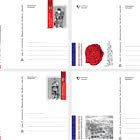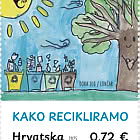2013Croatian Fauna - Amphibians - Set
2013 Croatian Fauna - Amphibians - Set for only GBP £1.09

- 08.04.2013
- Tomislav Tomić, academic painter graphic artist from Zaprešić
- -
- Zrinski - Čakovec
- Multicolor Offset Printing
- 4 Colours
- 29,82 x 35,50 mm
- 1,23
Fire-bellied toad or Bombina bombina (Linnaeus 1761) is an amphibian living in lowland habitats throughout central and east Europe from Denmark to Sweden in the north-west to Ural in Russia and Turkey in the south-east. It can mostly be found in lakes and ponds that do not dry out and in flooding lowlands overgrown by thick vegetation. It resides in shallow waters or close to the shore of typically clear standing waters, although it can be found in slowly flowing waters as irrigation canals. In the period of pairing, during day or in twilight the males stretched out on water surface emit sounds in order to attract potential partners. If they are successful, they will embrace a female with front limbs and fecundate eggs which the female most often lays among water plants. After hatching, tadpoles usually mostly feed on seaweed and after turning into toad they start to catch water insects and other invertebrates.
Despite of the adjective „fire-bellied” in its name, the raw skin on the back of an adult toad is usually olive green in colour with big dark patches and can be almost black. Only when it gets into trouble the orange to red colour characteristic for its belly becomes distinct on black background. The toad will turn on its back and push its belly upwards in order to warn the assailant of the poisonous substance it sends out through its skin. Though, in spite of this, some vertebrates feed on fire-bellied toad, especially birds.
Although at world scale it is not an endangered species and falls in the category of the least endangered species it is strictly protected in Croatia because it is threatened to disappear from its natural habitat due to urbanisation and agriculture development.
Jure Miočić-Stošić
Croatia - Recommended stamp issues
WOPA+ recommended stamp issues
| Avatar - Fire and Ash |
| Issued: 03.12.2025 |
| ›New Zealand |
| 50th Anniversary of the Founding of the 24th November Bar Scout |
| Issued: 24.11.2025 |
| ›Montenegro |
| Krisjanis Valdemars |
| Issued: 02.12.2025 |
| ›Latvia |
| Sign Language - Good |
| Issued: 02.12.2025 |
| ›Bosnia and Herzegovina - Republic of Srpska |
| In Memory of the Fallen and Murdered on October 7, 2023 |
| Issued: 08.10.2025 |
| ›Israel |
| Annual Collection Folder (New York) |
| Issued: 05.12.2025 |
| ›United Nations |
| Year Set |
| Issued: 24.11.2025 |
| ›Isle of Man |
| Shipping in the 17th and 18th Centuries - Peat Shipping |
| Issued: 05.12.2025 |
| ›Netherlands |




























